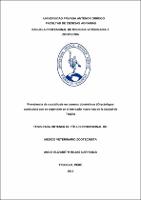Mostrar el registro sencillo del ítem
Prevalencia de coccidiosis en conejos domésticos (Oryctolagus cuniculus) que se expenden en el mercado mayorista de la ciudad de Trujillo
| dc.contributor.advisor | Briones Cabellos, Roberto | |
| dc.contributor.author | Rojas Carranza, Angie Elizabeth | |
| dc.creator | Rojas Carranza, Angie Elizabeth | |
| dc.date.accessioned | 2019-05-17T20:32:47Z | |
| dc.date.available | 2019-05-17T20:32:47Z | |
| dc.date.issued | 2019 | |
| dc.identifier.uri | https://hdl.handle.net/20.500.12759/4813 | |
| dc.description.abstract | El presente estudio tuvo por objetivo determinar la prevalencia de coccidiosis en Oryctolagus cuniculus en el mercado Mayorista de Trujillo durante los meses de agosto a noviembre del año 2017. Se tomaron como puntos de muestreo las tiendas donde se expenden estos especímenes, recolectando heces de los diferentes corrales, adquiriendo también ejemplares con signologías clínicas para efectuar el proceso de necropsia. Las muestras fueron conservadas en formol al 6% y procesadas en el Laboratorio de Parasitología de la Universidad Privada Antenor Orrego. Para el análisis se emplearon los métodos de Baermann modificado, por flotación con solución sobresaturada de azúcar, y el método directo; mientras que las necropsias fueron realizadas por la técnica de incisión decúbito dorsal. Obteniendo un resultado de 41,67% de muestras positivas tras la examinación de las muestras de heces recolectadas de los corrales, así mismo, todos los ejemplares sometidos a necropsia dieron positivo a Eimeria spp. Siendo los principales órganos infestados: el ciego con 60,0% y el intestino delgado con 100,0%; mientras que en el hígado se obtuvo un porcentaje de 40,0%. En la región intestinal los principales puntos de infestación fueron el íleon con 60,00 y el duodeno con 40,0%. | es_PE |
| dc.description.abstract | The objective of this current study was to determinate the prevalence of coccidiosis among Oryctolagus cuniculus in the Mayorista market of Trujillo during the months of august to november of 2017. For this investigation samples of diverse points of sale of domestic rabbits were selected to recollect the feces of different farmyards from this establishments, also acquiring specimens with clinical symptoms to execute a necropsy. The samples were collected on sterilized containers with clean spatulas to avoid bias, this containers were marked and preserved in a thermal container to being transport to the parasitology laboratory of Antenor Orrego Private University in which were preserved with one millimeter of formol at 10%. This samples were analyzed using the modify method of Baermann, flotation of feces with supersaturate sugar solution and the direct method; while the necropsies were made with the method of dorsal decubitus incision. Getting a result of 41, 67% of positive samples after the examination of the collected feces of the farmyards, in the same way all the specimens submitted to necropsy were positive presence of Eimera spp being the main spots of infestation the caecum with 60, 0% and intestine with 100, 0% while the liver obtained a percentage of 40,0%. On the intestinal region the main spots of infestation were the ileum with 60, 0% and duodenum with 40,0% each. | en_US |
| dc.description.uri | Tesis | es_PE |
| dc.format | application/pdf | es_PE |
| dc.language.iso | spa | es_PE |
| dc.publisher | Universidad Privada Antenor Orrego - UPAO | es_PE |
| dc.relation.ispartofseries | T_MED.VETE_122 | |
| dc.rights | info:eu-repo/semantics/openAccess | es_PE |
| dc.source | Universidad Privada Antenor Orrego | es_PE |
| dc.source | Repositorio Institucional - UPAO | es_PE |
| dc.subject | Coccidiosis | es_PE |
| dc.subject | Oryctolagus cuniculus | es_PE |
| dc.title | Prevalencia de coccidiosis en conejos domésticos (Oryctolagus cuniculus) que se expenden en el mercado mayorista de la ciudad de Trujillo | es_PE |
| dc.type | info:eu-repo/semantics/bachelorThesis | es_PE |
| thesis.degree.level | Título Profesional | es_PE |
| thesis.degree.grantor | Universidad Privada Antenor Orrego. Facultad de Ciencias Agrarias | es_PE |
| thesis.degree.name | Médico Veterinario Zootecnista | es_PE |
| thesis.degree.discipline | Medicina Veterinaria y Zootecnia | es_PE |
Ficheros en el ítem
Este ítem aparece en la(s) siguiente(s) colección(es)
-
Veterinaria y Zootecnia [163]

